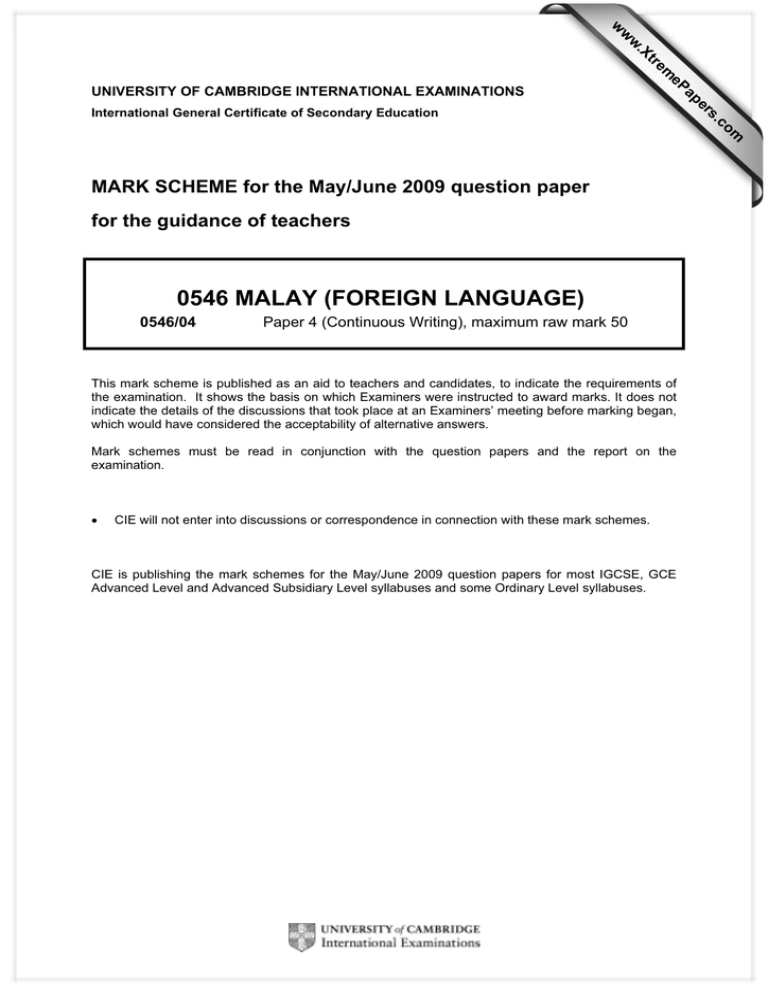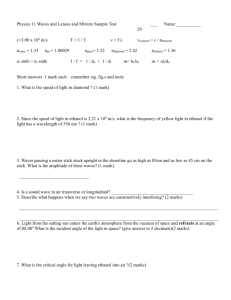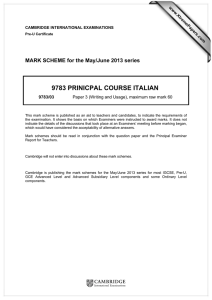0546 MALAY (FOREIGN LANGUAGE) for the guidance of teachers
advertisement

w w ap eP m e tr .X w UNIVERSITY OF CAMBRIDGE INTERNATIONAL EXAMINATIONS for the guidance of teachers 0546 MALAY (FOREIGN LANGUAGE) 0546/04 Paper 4 (Continuous Writing), maximum raw mark 50 This mark scheme is published as an aid to teachers and candidates, to indicate the requirements of the examination. It shows the basis on which Examiners were instructed to award marks. It does not indicate the details of the discussions that took place at an Examiners’ meeting before marking began, which would have considered the acceptability of alternative answers. Mark schemes must be read in conjunction with the question papers and the report on the examination. • CIE will not enter into discussions or correspondence in connection with these mark schemes. CIE is publishing the mark schemes for the May/June 2009 question papers for most IGCSE, GCE Advanced Level and Advanced Subsidiary Level syllabuses and some Ordinary Level syllabuses. om .c MARK SCHEME for the May/June 2009 question paper s er International General Certificate of Secondary Education Page 2 Mark Scheme: Teachers’ version IGCSE – May/June 2009 Syllabus 0546 Paper 04 Total marks for paper: 50 25 marks per question. Each question is marked over a maximum of 140 words. 1 Communication: 5 marks These marks are given for unambiguously communicated points of information as required by the rubric. 2 Language: 15 marks Ticks are awarded beside each Marking Unit which is substantially correct. Errors are not indicated. The total number of ticks is recorded at the foot of the page and converted to a mark out of 15 (see the conversion table on Page 7). 3 General Impression: 5 marks This mark takes the language mark as the first guide. It rewards attempts at interesting, idiomatic and ambitious use of language. It takes into account near misses or minor spelling errors not rewarded by the language mark and, conversely, it redresses the balance where weak expressions or repetition have been rewarded by the language mark (see table below). 0–1 Does not rise above the requirements for the Directed Writing Task in Paper 2 2 Fairly good use of idiom, vocabulary and structures. 3 Good use of the above. Generally accurate. 4 Very good use of the above. 5 Excellent use of the above. Recording of marks Marks are recorded at the end of the answer as follows: Communication E.g. 4/5 + + Language 10/15 + + General Impression 3/5 = = Total 17/25 Each mark (out of 25) is entered on the front of the script and the total out of 50 recorded. © UCLES 2009 Page 3 Mark Scheme: Teachers’ version IGCSE – May/June 2009 Syllabus 0546 Paper 04 Counting words (a) In letters, any address, date or invented titles are ignored. (b) The numbers of words is counted up to exactly 140 words – (or the nearest Marking Unit if just over) – this tally is indicated by ││. No marks are awarded thereafter either for communication or language. (c) A word is here defined as a group of letters surrounded by a space. Groups of letters containing hyphens are regarded as one word. E.g. anak-anak, huru-hara, berjalan-jalan: each example is one word. (d) Numbers count as one word whether written as figures or as words. 21 is one word. Dua puluh satu is treated as one word. Repetition of material printed in the rubric No accuracy marks are given for sentences/phrases of 3 words or more copied from the rubric. Irrelevant material In the (rare) case of a deliberately evasive answer which consists almost entirely of irrelevant material in defiance of the rubric a score of 0/25 is given. The genuine attempt to answer the question which fails due to a misunderstanding of the rubric will normally lose communication marks but will score for accuracy and quality of language. When part of an answer is clearly irrelevant it is included in the word count but bracketed and not awarded any accuracy marks. © UCLES 2009 Page 4 Mark Scheme: Teachers’ version IGCSE – May/June 2009 Syllabus 0546 Paper 04 MARKS FOR LANGUAGE General comments This positive marking scheme is intended to reward both accuracy and ambition. No marks are deducted for errors. Marking units A tick is awarded for a correct Marking Unit of which each element is correct. A spelling error will invalidate a Marking Unit. A Marking Unit may consist of any of the following: A noun or pronoun + verb. Extra marks are given for the use of the negative and interrogative. Kami mengharap = 1. Saya tulislah = 2. Dia tidak yakin = 2. Mengapakah orang itu berlari? = 2. Noun or pronoun + adjective or adjectival phrase. Dia besar = 1. Mereka marah = 1 . Dia pelajar yang pandai = 1. Urusan lain = 1. A mark is given for the possessive adjective and use of 'nya' in the possessive. lbu saya = 1. Kereta kawan saya = 1. Keretanya = 1. Kawan kereta saya = 0. Noun or pronoun + preposition or prepositional phrase. Wang di dalam = 1. Wangmu (1) di dalam (1). Ke Taiping = 1 . Naik bas = 1. Dengan kawan = 1 . Seperti saya = 1. Di depan kedai itu = 1. Untuk orang ini = 1. All adverbs (except sekali and sangat) and adverbial phrases of time/frequency. Dia besar sekali = 1. Dia terlalu besar = 2. Kita belum menyedari = 2. Orang datang (1) setiap minggu (1). And, similarly, 1 mark for: sudah, hampir, sedang, masih, akan, etc. and phrases of time e.g. besok, besok pagi, biasanya, tahun lalu, sebelum itu. But no marks are awarded for the time phrase and Marking Unit where confusion is caused by wrong use of time markers, e.g. Tahun lalu kami akan berangkat = 0. All conjunctions (except dan, atau and tetapi) Kerana = 1. Dia tahu (1) bahawa (1). Untuk = 1 And, similarly, 1 mark for: juga, kalau, namun, walaupun, etc. © UCLES 2009 Page 5 1 Mark Scheme: Teachers’ version IGCSE – May/June 2009 Syllabus 0546 Paper 04 Verbs (a) The simple root form of the verb is acceptable in most cases. Saya menulis surat = 1. Saya tulis surat = 1. Dia menelefon dan beritahu = 2, (two verbs using the same noun/pronoun). (b) Credit is given for correct use of modal or auxiliary verbs. Saya harus bangun = 2. Mereka ingin makan = 2. (and, similarly with: mau, senang, boleh...) Kita boleh pakai = 2. (c) Credit is given for correct use of suffixes ‘i’ and ‘kan’. Saya membangunkan = 2 (ekonomi = 1). lbu membelikan = 2 (saya baju = 0). Adik dimarahi = 3 (ibu). (d) Credit is given for correct use of prefixes ‘di’ and ‘ter’. Ikan itu dimasak = 2. See also: Adik dimarahi (above). Kampung terletak = 2. Banyak orang terkena (2) penyakit. 2 Nouns & Pronouns (a) On their own these don't score. No score also for nouns with: ini, itu, banyak, sedikit, with numbers or ‘nya’ (unless clearly a possessive). Masalah ini = 0. Banyak negara = 0. Dua alasan = 0. (b) However, nouns used with their correct count noun do score. Seorang pencuri = 1. Sebuah patung = 1. Sepuluh helai kertas = 1. (c) NB (as mentioned above) a spelling error invalidates the Marking Unit. Pesawat terbang mendarat = 0. Makan saya = 0, (meaning makanan saya). (d) Misspelling of proper nouns in the case of a person's name or a town or place is tolerated. Common countries should be correctly spelt, however both Singapore and Singapura are accepted. (e) Noun + pun = 1. Rumahpun (1) dia tidak (1) ada (1). (f) Bukan + noun = 1. Bukan kawan = 1. 3 Adjectives (a) See above. Comparatives and superlatives: Rumah itu lebih besar (2) daripada (1). Kapal ini sama besar (1) dengan (1). Dia sebesar (1) saya. Dia anak yang paling (1) pintar (1). (Telefon umum yang) terdekat = 2. (b) Groups of adjectives in descriptive writing also count: Kami letih, lapar dan haus = 3. 4 Interrogative adverbs Score 1 tick separately: Bagaimana? Berapa? Di mana? Bila? Mengapa? Siapa? Each scores 1. © UCLES 2009 Page 6 5 Mark Scheme: Teachers’ version IGCSE – May/June 2009 Syllabus 0546 Paper 04 Slang (a) The aim is for ‘Bahasa Melayu yang baik dan betul’. While shortened versions of most verbs are acceptable these should not become slangy. E.g. Mereka tengok aje. Saya tak tahu camana SMS or text language and that used in chatrooms are discouraged. E.g. apasal? camner? (b) While tidak is formal, tak is common in printed form and acceptable; (c) Although the Malay language is very similar to the Indonesian language, Indonesian words which have a totally different meaning must not be used. E.g.: bisa when you can use boleh, karena when you can use kerana, kapan when you can use bila. 6 Miscellaneous Ada + noun or pronoun = 1 Ada banyak rumah = 1. Tidak (1) ada waktu (1). Ada + yang = 1 (Ada + noun or pronoun + yang still earn only 1 mark) Ada yang (1) menelefon. Ada beberapa orang yang (1) tahu (1). Apa + yang = 1 Saya tahu (1) apa yang (1) harus saya lakukan (1). Examples: Di Australia (1) ada rumah-rumah (1) yang kecil (1) (preposition) (ada + noun) (adj. phrase) Ada kereta, trak, basikal motorsikal dan lain-lain = 1 (Giving one mark only for an illustrative list seems harsh, but can be redressed in the impression mark). 7 Expressions With experience, more will doubtless be added to the following list. Credit would be appropriate, for example, for: Menurut saya = 1. Misalnya = 1. Oleh kerana itu = 2. Ternyata = 1. Namun demikian = 2. Rupanya = 1. Pada jam lapan = 1. Kelihatannya = 1. Pada jam lapan malam = 2. Dari jam lima sampai jam tujuh = 2. 8 English borrowings Only English (or other foreign borrowings) are acceptable if clearly understandable to a 'native Malay speaker with no knowledge of languages other than Malay'. E.g. produk, bisnis (but not 'business'), industri (but not 'industry') etc. © UCLES 2009 Page 7 9 Mark Scheme: Teachers’ version IGCSE – May/June 2009 Syllabus 0546 Paper 04 Register Kamu, kau etc are not acceptable in a formal letter but Anda is accepted in an informal letter. Glaringly inappropriate register is disallowed. For learned phrases of formality in a letter: Kepada yang berhormat Encik = 3. Dengan surat ini kami ingin menyampaikan = 3. For learned phrases in an informal letter: Semoga kamu baik-baik = 2. Bagaimana khabar? and Apa khabar? Each score 1. 10 Hyphens and punctuation Inaccuracies in the use of hyphens and punctuation are ignored. Conversion Table Number of ticks Max 60 Mark out of 15 (for Accuracy of Language) 60+ 55–59 51–54 48–50 45–47 42–44 38–41 34–37 30–33 26–29 22–25 19–21 15–18 11–14 7–10 0–6 15 14 13 12 11 10 9 8 7 6 5 4 3 2 1 0 Pro rata (General Impression)* Max 5 5 5 4 4 4 3 3 3 2 2 2 1 1 0 0 0 *This mark may be adjusted up or down by one mark depending on the criteria mentioned above under GENERAL IMPRESSION. © UCLES 2009 Page 8 Mark Scheme: Teachers’ version IGCSE – May/June 2009 Syllabus 0546 Paper 04 COMMUNICATION MARKS The criteria for awarding communication marks is that a sympathetic native Malay speaker with no knowledge of languages other than Malay should understand. QUESTION 1 A maximum of 5 marks are available for each of the two questions. Marks are to be awarded for the following points: Question 1(a): A group of young Malaysian students is coming to visit your school. Write a letter to the Malaysian group to tell them about your school life: (i) (ii) (iii) (iv) Describe your school life. Say what you like about school and why. Say what you don't like and why. Describe the programme for the visit. [1] [1] [1] [1] + 1 mark for a further relevant detail Question 1(b): You are looking for a holiday job in Malaysia and you find an advert from the Malaysian Tourist Office who are looking for a student to help out in the holidays. Write a letter to apply for the job. Explain: (i) why you would like the job (2 details); (ii) why you are the right person for the job (2 details); (iii) when you will be available. [1 + 1] [1 + 1] [1] QUESTION 2: Narrative You were walking home from school with some friends when you noticed a teenager grabbing a lady's bag at a bus stop. What happened next. 1 mark for each detail relevant to the account of what happens, up to a maximum of 5 marks [1 + 1 + 1 + 1 + 1] © UCLES 2009

